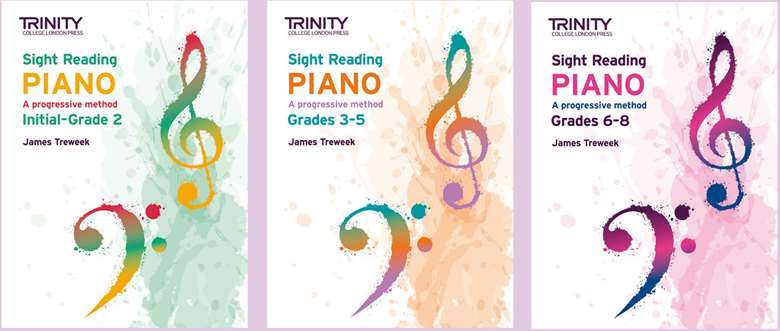Piano Reviews: TCL Sight Reading Piano
Rachael Gillham
Tuesday, June 1, 2021
Rachael Gillham shares her thoughts on James Treweek's Sight Reading Piano: A progressive method, printed by Trinity College London

Sight Reading Piano: A progressive method is a new publication for Trinity College London (TCL). The author of the three-book collection is James Treweek, who currently teaches at Sevenoaks School and has some 25 years’ experience of piano pedagogy. In addition to teaching, he is in demand as a musical director and arranger.
The books themselves are eye-catching, with attractively designed and uncluttered covers, and each volume covers three Grades from Initial to Grade 8. My first impression on opening the books is how well bound they are – they open easily and stay open on the piano without breaking the spine. The print and layout are clear, and each book follows the exact same formula, which builds on the accumulative approach taken.
Each book makes use of one highlight colour to draw attention to various aspects within the lessons. These consist of a new musical concept from note reading, scales, musical terms and rhythms, to phrasing, ornamentation and more. Each lesson has four practice exercises, culminating in a duet to sight read with the teacher. This is written in the format of a full score, and the pupils’ part is highlighted in the books’ colour.
The use of a duet at the end of each lesson is a fantastic addition to these volumes. I have rarely come across a student who doesn't enjoy playing duets, and opportunities for regular ensemble music are sadly all too often neglected with other work to get through in lessons. The duets consolidate and reemphasise the points covered in each lesson.
Lastly, each lesson has a box with a lightbulb at the end. These contain tips and encouraging advice pertinent to the pupils’ level and serve to really make pupils think as they play. For example, in Grade 1; ‘Your teachers’ rhythm may be different to yours, so keep a strong sense of pulse in your mind’ and in Grade 8; ‘Think carefully when you encounter complex time signatures. They are usually not as difficult as they look, and they tend to use repetitive rhythms.’
To look in more depth at how the material for each grade is presented, here are some of the lessons in Grade 1: Reading hands together; the dynamic marking mf; the time signature 4/4; learn semibreve note and minim rest; the key of A minor; the key of G major; reading the keys of C, G major and A minor, and time signatures 4/4 and 2/4; extended note ranges in A minor, G major, and C major, then in all three keys.
All the books build on knowledge previously learnt and the progression is in very gentle increments. Advanced students at Grade 8 level cover the following: The key of Db major and the term pp; the key of B major and the term ff; reading complex time signatures; the key of Bb minor and dynamics as text; reading triplets and duplets; double sharps and double flats; the key of G# minor; the articulation tenuto and playing different dynamics in each hand; reading in 2/2 and changing time signatures.
Sight reading is an invaluable skill for the musician. From a young beginner taking their very first steps, to musicians beyond the teaching studio. To have the ability to open any book (of their level) and be able to translate the score into music is really what anyone wants. I remind pupils that there is no great mystery and sight reading, like scales and repertoire, is a skill that can be learned.
I highly recommend these books. They could be used from the first few lessons and, as well as their intended use, there is potential for developing the material for sight singing, improvising and simple transposing using sol-fa. They are good value for money, especially as each book covers three grade levels, and the exercises are musically written in a variety of styles and not at all repetitive.
I'm particularly excited to see how the Initial Grade is received by my younger new pupils, and I'm sure my more seasoned pupils will love the new duets. Returning to school for the new term, these are firmly packed in my teaching bag!

